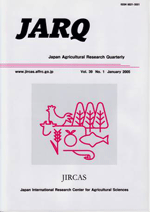Effect of Feeding Milk Replacers on the Tissue Burden of Polychlorinated Dibenzo-para-dioxins, Dibenzofurans, and Dioxin-like Polychlorinated Biphenyls in Suckling Beef Calves
| ISSN | 00213551 |
|---|---|
| NII recode ID (NCID) | AA0068709X |

To reduce the intake and accumulation of dioxins and dioxin-like compounds in nursing beef calves, the concentrations of seven polychlorinated dibenzo-para-dioxins (PCDDs), 10 polychlorinated dibenzofurans (PCDFs), and 12 dioxin-like polychlorinated biphenyls (PCBs) were analyzed and compared in the natural milk of grazing beef cows and bovine milk replacers, and in the blood, testis, and adipose tissue of mother-fed and bottle-fed calves at two months of age. The total toxic equivalent quantities (TEQs) of these compounds were approximately tenfold less (P < 0.001) in synthetic milk substitute and starter feed for calves than in natural milk (1.0 and 0.88 vs. 9.28 pg/g-lipid, respectively). The TEQ in the blood of mother-fed calves increased (P < 0.01) two months after birth (1.35 vs. 8.44 pg/g-lipid), whereas no difference in TEQ was found in bottle-fed calves between birth and two months of age (0.94 and 0.93 pg/g-lipid, respectively). Consequently, TEQs in the blood, testis, and adipose tissue were less (P < 0.05) in bottle-fed calves as compared with mother-fed calves at two months of age (0.93 vs. 8.44, 4.97 vs. 21.7, and 5.17 vs. 18.1 pg/g-lipid, respectively). Regarding individual congeners, the concentrations of dioxins with four or five chlorine substitutions were lower (P < 0.05) in synthetic milk substitute and starter feed than in natural milk, whereas the concentrations of hepta- and octa- chlorinated congeners were conversely higher in synthetic milk substitute and starter feed. Similarly, the accumulation of tetra- and penta- chlorinated congeners in adipose tissue of bottle-fed calves was lower (P < 0.01) than that in mother-fed calves. In contrast, congener specific accumulation characteristics like PCDDs were not observed in PCDFs and dioxin-like PCBs, and none of these congeners detected in bottle-fed calves were greater than that found in mother-fed calves. These results suggest that the feeding of milk replacers can markedly reduce the intake and accumulation of dioxins and dioxin-like compounds in nursing beef calves as compared with natural feeding, because the milk replacers contain preferably lower concentrations of these compounds than in natural milk.
| Date of issued | |
|---|---|
| Creator | Makoto HIRAKO Kenji ENDO |
| Subject |
beef cattle body burden neonatal calf organochlorine compound tissue accumulation |
| Available Online | |
| NII resource type vocabulary | Journal Article |
| Volume | 50 |
| Issue | 2 |
| spage | 153 |
| epage | 161 |
| DOI | 10.6090/jarq.50.153 |
| Rights | Japan International Research Center for Agricultural Sciences |
| Relation | : J-STAGE |
| Language | eng |
